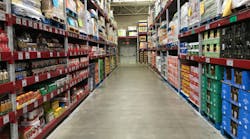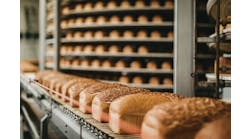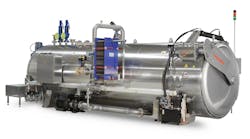Getting products onto the store shelf is the last step before purchase. With retail-ready secondary packaging, it can be a short step.
Retail-ready cases are designed to sit directly on shelves, counters or wherever a retailer wants. They can appear as is or with minimal modification, such as tearing off a pre-scored top half. The point is to make things easier for retail workers, and often, to give an item some extra shelf presence.
Among the former applications are discount grocers who routinely put full cases directly on store shelves to save on labor; among the latter, impulse items at convenience stores or in strategic supermarket locations like deli counters.
Getting a product into a retail-ready case isn’t as challenging as it may look, but it does take specialized equipment and packaging materials. Processors who want to go that route should be able to do so with the right cooperation from suppliers.
Equipment Solves a Company’s Pickle
Oh Snap! Pickling Co. had one of the best challenges a food processor can: managing explosive growth. The company, a division of GLK Foods, produces single-serve pickled cucumbers, carrots and other veggies as impulse items in channels like convenience stores and supermarket deli counters.
Established in 2015, Oh Snap!’s business grew so fast that it established a new processing plant in Little Chute, Wis. The plant came online in March, and even with the pandemic, it’s running around the clock, six days a week.
To keep up with the demand of almost 2 million single-serve pouches per week, Oh Snap! is installing two 424 W3 wraparound case packers from Somic. They use decentralized servo drives to collate and case pack up to 160 pouches per minute into six-, 12- or 18-count display cartons. Changeovers average 30 minutes, says company president Ryan Downs, and is done with kipp handles and end-of-arm tooling, with no extraneous tools required.
The first step is determining whether the primary package can be displayed to its best advantage, or even at all, in a retail-ready case. The best candidate would be a package that can stand up on its own, like a pouch with a gusseted bottom.
However, that can be expensive, requiring a specialized filling machine and materials. An attachment is available for some older fillers that will tuck in each side of the bag as it’s being sealed – what Chris Calabrese, vice president of sales for Fallas Automation, calls “an inexpensive way to accomplish a tucked corner gusset.”
But with the right kind of case packer, a pouch isn’t even necessary.
“There is no question the stand-up pouch had been a big player in our retail ready packages,” says Peter Fox, senior vice president of sales for Somic America. “However, we are probably standing up just as many flow packs (cookies for example) and cartons as we are stand up pouches.” Other primary packages that can go into retail-ready cases include thermoformed trays, card-backed products and bottles.
Material issues
The primary package can vary, but the case itself has to be specifically designed for retail display. The most common materials are paperboard, which has a good shelf appearance, and corrugated, which is durable enough for transit. Many retail-ready cases will combine the two.
“We run either paperboard or corrugated in our retail ready designs; many times we run a paperboard display tray along with a corrugated cover,” Fox says. “This combination provides the corrugated for the distribution packages as well as the paperboard for an upscale shelf-ready display.”
A good appearance is important, which is why retail-ready cases are usually sealed with hot-melt glue instead of tape. “It’s no longer acceptable to have a piece of tape wrapped around the front of the tray or case when it’s on the shelf,” says Rick Gessler, vice president of engineering for Delkor Systems. By the same token, edges need to be smooth, with no jagged cuts.
Retail-ready cases often have unusual shapes, like sloping sides. It’s also common for them to have tear-off tops. These require die-cut case blanks with folds, creases and scoring.
Fox says that, while retail-ready case blanks are widely available, Somic tries to include certain features that will make them run more easily. “These things are specific perforation patterns that we like to use on scores where we may not have a very large amount of material to leverage to break a score, or die-cut knockouts that we glue covers to that provide material removal upon opening,” he says.
“Many of these little features are what makes our end product a much more attractive premium retail display carton.”
Impulse items like microwavable burritos are often candidates for display in retail-ready cases. Photo: Delkor
Calabrese notes that the blanks Fallas works with, featuring tear-off tops, are designed so that the tabs that get popped or pushed inward to assist in tearing the perforations while assembling the case remain stuck to the portion discarded. That way, they don’t fall off and have to get picked up once the case is opened.
Delkor uses, and makes available, the Cabrio Case, a patented design for retail-ready case blanks. It’s a single-piece, tray/hood package, made from B-flute corrugated. Retailers can pop off the top, leaving a tray with a clean, customizable front edge.
Handling the case
The biggest factor in retail-ready cases is the case packer. It has to handle the complicated and sometimes delicate task of unfolding and assembling a complex blank and placing products inside.
Retail-ready case packing will almost always involve handling many more cases than regular packing, due to the quantities involved. A regular slotted container might hold two dozen or more primary packages; a retail-ready case might have as few as four. “This drives up your case-packing run rate quite a bit,” Gessler says.
Manipulating the case blank often is more challenging with retail-ready cases, especially when they’re in two pieces, Fox says. “The folding and gluing of a two-piece package is not a common function on a machine.” It takes precise manipulation by components like suction cups, closing units and cover applicators, often powered by servomotors.
Another big challenge is getting the primary packages into the case, which has to be done neatly to ensure a good shelf appearance. Regular case-packing usually involves dropping or lowering the packages into the case, but with retail-ready, it’s not always that simple. A given application might require the primary packages to lay flat or to stand; in some cases, packages might have to be rotated 180 degrees away from each other.
The basic choice is what to rotate and orient during case-packing: the primary packages or the case. Fallas Automation offers both with its Adabot line. The R700 Adabot places pouches and other packages directly into cases, which can go on the pallet so that the pouches inside are either upright (allowing product to settle) or flat (for greater stacking strength).
The more expensive R700 Adabot-LV (for “lay flat” and “vertical”) uses buckets to accumulate primary packages. They are placed individually into the bucket, which then collapses and rotates into the case to deposit them inside in a stand-up orientation. It can be set up so that the pouch gussets are facing out when the bucket holds them; the bucket then twists to put the pouches inside the case with the gussets down.
Delkor, on the other hand, prefers not to use application-specific buckets or rams, Gessler says. It favors vision-based robots that can build patterns of primary packages, then use another robot or gantry to place them into the case.
Change challenge
Processors often want retail-ready cases to carry different numbers of primary packages, which requires changing over. Doing so efficiently is especially challenging because of the extra complexity involved in handling retail-ready case blanks in the first place.
“We typically will run seven or eight different formats on our machines,” Fox says. “These may include some retail-ready, premium two-piece packages, a single component tear apart retail-ready package, or a single component wraparound standard case. Other variations may be lying flat or standing up, or just variations on the case count.”
Retail-ready case packing involves putting primary packages inside a case that is intended to be displayed on a store shelf or counter. Photo: Aagard
Changeover, he says, ranges from 2 to 20 minutes, depending on complexity: whether the change involves the primary package type, the case size, or both. Changeovers can be done automatically, manually, or a combination of the two.
“Usually there is a range of capability needed to accommodate different package formats and product sizes for the customer,” says Ross Feiler, lead applications engineer for Aagard Group. “In any case, every dimension can change from one size to another, and this can be handled fully automatically, semi-automatically or manually.”
Automatic changeover requires servomotors and a sophisticated interface, which add to the machine’s expense. Its biggest advantage is making things easier for workers, who won’t have to be trained in changeover procedures. However, workers who know what they’re doing can do changeovers as fast or faster than servomotors.
Delkor prides itself on being “quick-change masters,” Gessler says. At every Pack Expo, the company does changeover demonstrations that reconfigure a case-packer from 12 or more per case to a three- or four-count Cabrio.
Retail-ready cases are a fixture in all sorts of sales channels, and their use will likely increase. Judicious selection of machinery and materials will make it easier to fulfill this complex trade demand.


